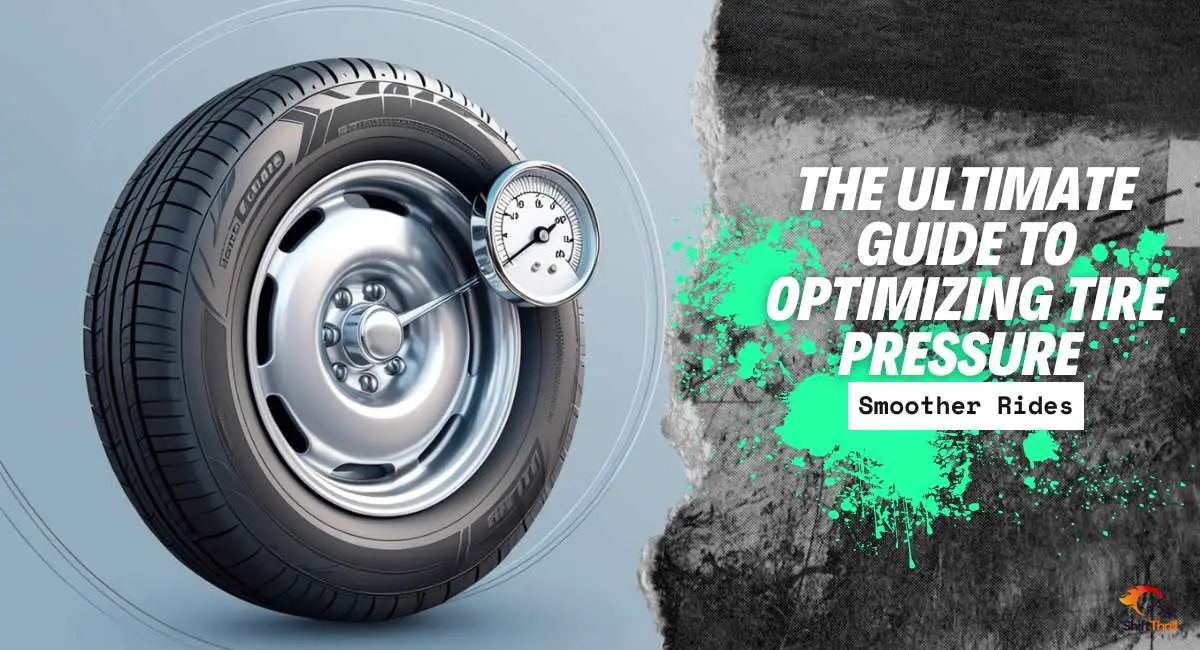Tire pressure is often overlooked as a crucial factor in vehicle maintenance, yet it plays a vital role in ensuring both comfort and safety while driving. Proper tire inflation not only enhances ride quality but also maximizes fuel efficiency, extends tire life, and ensures safe handling. This comprehensive guide delves into the science behind tire pressure, its impact on driving performance, and how to optimize it for various conditions to enjoy a smoother, safer ride.
Understanding Tire Pressure Basics
Tire pressure, typically measured in pounds per square inch (PSI), represents the amount of air inside the tire that supports the vehicle’s weight and helps maintain proper contact with the road. Tire inflation affects key aspects of your vehicle’s performance, including handling, fuel economy, and comfort.
The optimal tire pressure for your vehicle can usually be found in the owner’s manual, on a sticker inside the driver’s door, or sometimes on the gas tank door or glove compartment. It’s important to note that this recommended pressure is based on normal driving conditions and may need to be adjusted depending on factors such as load weight and environmental conditions.
Research from the U.S. Department of Energy reveals that for every 1 PSI drop in pressure across all four tires, gas mileage decreases by about 0.2%. Over time, under-inflated tires can result in hundreds of dollars in extra fuel costs and significantly reduce tire lifespan. Conversely, over-inflated tires reduce traction, make the ride stiffer, and increase the risk of blowouts on rough terrain.

Factors Affecting Tire Pressure
Tire pressure is not static and can fluctuate due to several factors, including ambient temperature, vehicle load, and driving conditions. Let’s explore these in more detail:
- Ambient Temperature: Temperature fluctuations have a direct impact on tire pressure. For every 10°F change in temperature, tire pressure can increase or decrease by approximately 1 PSI. In winter, cold air contracts, leading to a decrease in pressure, while in summer, heat causes the air inside the tires to expand. Drivers should be particularly vigilant during seasonal transitions and check their tire pressure more frequently.
- Load Weight: Heavier loads put more stress on tires, causing the sidewalls to compress and increasing rolling resistance. When carrying heavy cargo or towing, it’s advisable to slightly increase the tire pressure within the manufacturer’s allowable range. This helps ensure the tires can properly support the added weight, reducing the risk of overheating and excessive wear.
- Road Conditions: Different terrains require different tire pressures. On smooth, paved roads, maintaining the manufacturer’s recommended PSI ensures balanced performance. However, for off-roading or driving on loose surfaces such as sand or snow, reducing tire pressure by a few PSI can improve traction. This technique, known as “airing down,” allows the tires to spread out and grip uneven surfaces more effectively.
- Driving Style: Aggressive driving, characterized by sharp turns, hard braking, and high speeds, heats the tires more quickly, which can cause the air inside to expand and temporarily raise tire pressure. In contrast, conservative driving at moderate speeds in city traffic places less strain on the tires, meaning less variation in pressure.
How to Measure Tire Pressure Accurately
Ensuring accurate tire pressure readings is key to optimizing both safety and performance. A high-quality tire pressure gauge, either digital or analog, is essential for this task. Here’s a step-by-step guide:
- Find the Recommended Pressure: Locate the manufacturer’s recommended PSI in your vehicle’s manual or on the label inside the driver’s door.
- Measure When Cold: Always check tire pressure when the tires are cold. “Cold” in this context means after the vehicle has been sitting for several hours or driven less than a mile, as heat from driving can temporarily increase tire pressure.
- Use a Tire Pressure Gauge: Unscrew the valve cap and press the tire pressure gauge onto the valve stem. A digital gauge will display the pressure instantly, while an analog gauge will pop out a measurement.
- Compare and Adjust: Compare the reading to the recommended PSI. If the pressure is lower than recommended, add air in small increments and check again until the correct pressure is reached. If the pressure is too high, release air gradually by pressing the valve until the desired pressure is achieved.
- Monitor Regularly: Tires naturally lose about 1-2 PSI per month, so regular checks (at least monthly) are essential. It’s especially important to check before long trips or drastic weather changes.
Consequences of Incorrect Tire Pressure
Incorrect tire pressure can lead to a range of issues that not only affect ride quality but also compromise safety and increase costs:
- Under-Inflation: According to the NHTSA, 25% of vehicles on the road have under-inflated tires. Low tire pressure causes increased rolling resistance, which leads to excessive heat buildup. This heat accelerates tread wear, can cause blowouts, and negatively impacts fuel efficiency. Research indicates that under-inflated tires reduce fuel economy by up to 3%, which can cost drivers around $112 annually, based on average U.S. fuel prices and driving patterns.
- Over-Inflation: Over-inflated tires reduce the tire’s contact patch with the road, leading to decreased traction, longer braking distances, and uneven wear concentrated in the center of the tread. Additionally, over-inflated tires provide a rougher, less comfortable ride because they are less capable of absorbing road imperfections. Over-inflation also increases the risk of tire failure on rough roads.
Both scenarios can affect vehicle handling, leading to reduced stability, compromised braking performance, and longer stopping distances, especially in wet or icy conditions.
Optimizing Tire Pressure for Different Conditions
Optimizing tire pressure isn’t a one-size-fits-all approach; it requires adjustments based on the type of driving and external factors.
- City Driving: In urban environments where driving involves frequent stops and starts, maintaining the manufacturer-recommended tire pressure offers the best balance of fuel efficiency and comfort. Properly inflated tires help ensure good traction for smooth acceleration and braking.
- Long-Distance Travel: When embarking on a long road trip, especially on highways, you may consider slightly increasing tire pressure (within safety limits). This helps reduce rolling resistance, which can boost fuel efficiency over long distances. However, be cautious not to exceed the recommended PSI, as over-inflation can lead to a harsher ride and increase wear in the center of the tread.
- Heavy Loads and Towing: For drivers who regularly carry heavy loads or tow trailers, increasing tire pressure by 2-3 PSI (or more, as recommended by the manufacturer) can help compensate for the added weight. This ensures that the tires maintain their shape, reducing the risk of overheating and blowouts.
- Off-Roading: When driving on soft terrain such as sand, snow, or mud, reducing tire pressure can significantly improve traction. Airing down the tires by 5-10 PSI allows them to spread out and create a larger contact patch, improving grip and reducing the likelihood of getting stuck.
Common Myths About Tire Pressure
Misinformation about tire pressure can lead to poor maintenance practices and potential safety issues. Let’s debunk some common myths:
- Myth: Higher Pressure Always Improves Fuel Efficiency: While slightly increasing tire pressure can reduce rolling resistance and improve fuel efficiency, over-inflating tires beyond the recommended level can lead to safety hazards such as reduced traction, uneven wear, and a higher risk of blowouts. The modest fuel savings often do not justify the potential risks.
- Myth: Lower Pressure Provides a Smoother Ride: Although under-inflated tires may feel softer at low speeds, they generate more friction with the road, leading to excessive heat buildup and premature wear. The added friction also worsens fuel efficiency and increases the risk of tire failure, especially at higher speeds.
The Role of Tire Pressure Monitoring Systems (TPMS)
Many modern vehicles come equipped with Tire Pressure Monitoring Systems (TPMS), designed to alert drivers when tire pressure falls below a certain threshold. While TPMS is a valuable tool for maintaining tire pressure, it’s important to understand its limitations.
TPMS typically alerts drivers when tire pressure drops by 25% or more below the recommended level. This means that a tire could be significantly under-inflated before the system triggers a warning. Additionally, TPMS doesn’t notify drivers if the tire is over-inflated or slightly under-inflated. Therefore, manual checks with a gauge are still necessary to ensure optimal pressure.
Conclusion
Maintaining proper tire pressure is a critical aspect of vehicle upkeep that influences safety, ride comfort, fuel economy, and tire longevity. Regularly checking and adjusting your tire pressure based on the manufacturer’s guidelines, driving conditions, and external factors can enhance your driving experience and extend the life of your tires. While TPMS provides an added layer of protection, manual pressure checks remain essential for precise tire maintenance. By taking these steps, you’ll ensure a smoother, safer, and more efficient ride every time you hit the road.
